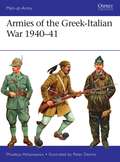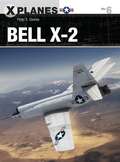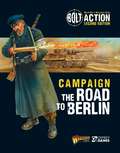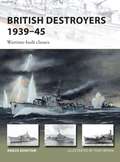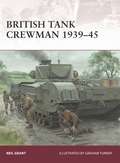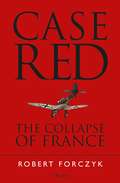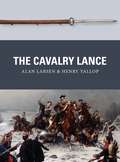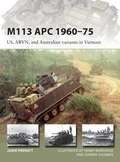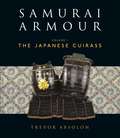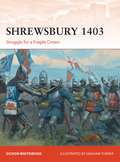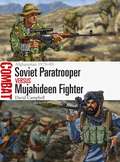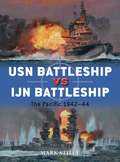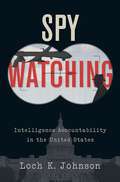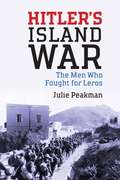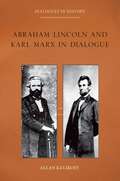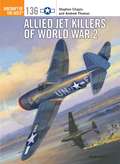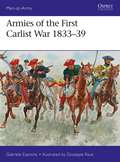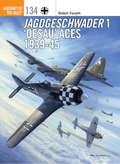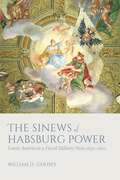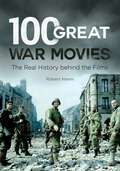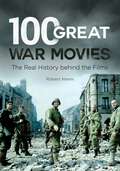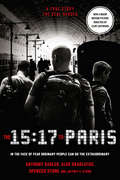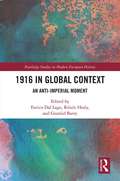- Table View
- List View
Armies of the Greek-Italian War 1940–41 (Men-at-Arms)
by Peter Dennis Phoebus AthanassiouIn October 1940 an Italian army some 200,000 strong invaded Greece across its largely undefended border with Albania. Although supported by Great Britain, at first by sea and in the air and later by landing British and ANZAC troops from North Africa, Greece bore the main brunt of the six-month war. Outclassed in materiel and outnumbered, LtGen Papagos's Greek army was so successful against the Italians in north-west Greece that, by 22 November 1940, it was advancing into Italian-held Albania. This would eventually force Hitler to send in German reinforcements to support his beleaguered Italian allies, delaying his invasion of the Soviet Union. Complete with contemporary photographs and full-colour uniform plates, this fascinating study explores the history, organization, and appearance of the armies of this oft forgotten conflict.
Bell X-2 (X-Planes)
by Adam Tooby Peter E. DaviesEven before the spectacular success of its X-1 rocket-powered aircraft in breaking the 'sound barrier', the adventurous Bell Aircraft Corporation was already pushing ahead with a parallel project to build a second aircraft capable of far higher speeds. The X-2 (or Model 52) explored the equally uncertain technology of swept-back wings. Now common in modern conventional fighter aircraft, the Bell X-2 was revolutionary in using this type of airframe to probe Mach 3 and research the effects of extreme aerodynamic friction heat on airframes. Although both X-2s were destroyed in crashes after only 20 flights, killing two test pilots, the knowledge gained from the programme was invaluable in developing aircraft that could safely fly at such speeds. Using stunning artwork and historical photographs, this is the story of the plane that ultimately made the Lockheed Blackbird and Concorde possible.
Bolt Action: The Road to Berlin (Bolt Action)
by Warlord Games Peter DennisAs the Allies advance towards Germany, they face dogged resistance from the hard-pressed German forces. Take command of the Allies in their final push to end the war in Europe, or hold fast as the German defenders as the fight is brought to your door. This new Campaign Book for Bolt Action offers new linked scenarios, rules, troop types and Theatre Selectors, and provides plenty of options for novice and veteran players alike.
British Destroyers 1939–45: Wartime-built classes (New Vanguard)
by Tony Bryan Angus KonstamAs the possibility of war loomed in the 1930s, the British Admiralty looked to update their fleet of destroyers to compete with the new ships being built by Germany and Japan, resulting in the commissioning of the powerful Tribal-class. These were followed by the designing of the first of several slightly smaller ships, which carried fewer guns than the Tribals, but were armed with a greatly enlarged suite of torpedoes. The first of these, the 'J/K/M class' was followed by a number of wartime variants, with slight changes to their weaponry to suit different wartime roles.Designed to combat enemy surface warships, aircraft and U-boats, the British built these destroyers to face off against anything the enemy could throw at them. Using a collection of contemporary photographs and beautiful colour artwork, this is a fascinating new study of the ships that formed the backbone of the Royal Navy during World War II.
British Tank Crewman 1939-45 (Warrior)
by Graham Turner Neil Grant Nikolai BogdanovicGreat Britain had introduced the tank to the world during World War I, and maintained its lead in armoured warfare with the 'Experimental Mechanised Force' during the late 1920s, watched with interest by German advocates of Blitzkrieg. Despite these successes, the Experimental Mechanised Force was disbanded in the 1930s, making Britain relatively unprepared for World War II, both in terms of armoured doctrine and equipment. This fully illustrated new study examines the men who crewed the tanks of Britain's armoured force during World War II, which was only four battalions large in 1939. It looks at the recruitment and training of the vast numbers of men required, their equipment, appearance and combat experience in every theatre of the war as the British armoured division sought to catch up with the German Panzers.
Case Red: The Collapse of France
by Robert ForczykEven after the legendary evacuation from Dunkirk in June 1940 there were still large British formations fighting the Germans alongside their French allies. After mounting a vigorous counterattack at Abbeville and then conducting a tough defence along the Somme, the British were forced to conduct a second evacuation from the ports of Le Havre, Cherbourg, Brest and St Nazaire. While France was in its death throes, politicians and soldiers debated what to do – flee to England or North Africa, or to seek an armistice.Case Red captures the drama of the final three weeks of military operations in France in June 1940, and explains the great impact it had on the course of relations between Britain and France during the remainder of the war. It also addresses the military, political and human drama of France's collapse in June 1940, and how the windfall of captured military equipment, fuel and industrial resources enhanced the Third Reich's ability to attack its next foe – the Soviet Union.
The Cavalry Lance (Weapon)
by Peter Dennis Alan Larsen Henry YallopThe development of cavalry firearms and the widespread disappearance of armour from the European battlefield saw a decline in the use of the cavalry lance in early modern warfare. However, by 1800 the lance, much changed from its medieval predecessors in both form and function, was back.During the next century the use of the lance spread to the armed forces of almost every Western country, seeing action in every major conflict from the Napoleonic Wars to World War I including the Crimean and Franco-Prussian wars and across the Atlantic in the American Civil War. The lance even reached the colonial conflicts of the Anglo-Sikh and Boer wars. It was not until the disappearance of the mounted warrior from the battlefield that the lance was consigned to history.Featuring specially commissioned artwork and drawing upon a variety of sources, this is the engaging story of the cavalry lance at war during the 19th and 20th centuries, from Waterloo to the Somme.
M113 APC 1960–75: US, ARVN, and Australian variants in Vietnam (New Vanguard)
by Johnny Shumate Henry Morshead Jamie PrenattThe M113 is the most widely used and versatile armoured vehicle in the world. Fielded in 1960 as a simple 'battlefield taxi', over 80,000 M113s would see service with 50 nations around the world and 55 years later, many thousands are still in use. In addition to its original role of transporting troops across the battlefield, specialized versions perform a multitude of other functions including command and control, fire support, anti-tank and anti-aircraft defence, and casualty evacuation.This new fully illustrated study examines the service record of the M113 from its initial fielding through to the end of the Vietnam War. It will also describe the many US, South Vietnamese, and Australian variants of the M113 used in the Vietnam War as well as information on tactics, unit tables of organization and equipment, and a selection of engagements in which the M113 played a decisive role.
Samurai Armour: Volume I: The Japanese Cuirass
by Trevor AbsolonFor beauty, precision and strength, nothing has ever matched the combination of form and function found in the armour of the samurai. For a samurai, the consummate warrior, his suit of armour was so much more than 'just' protective equipment that could save his life in the heat of battle – it was the embodiment of his personality, social status and very soul. This volume, the first in a two-part series on the armour of the samurai, traces first the history of the samurai themselves and then examines the history and evolution of the cuirass or dou, the armour protecting the samurai's chest. Drawing on over 20 years of research and technical work by Trevor Absolon, a leading expert, this is a complete study of this fundamental aspect of samurai armour construction. Illustrated throughout with photographs and diagrams, this is more than just a detailed technical exploration, it is a meditation on a process that was, and still is, nothing short of an art form.
Shrewsbury 1403: Struggle for a Fragile Crown (Campaign)
by Graham Turner Dickon WhitewoodThe battle of Shrewsbury in 1403 is one of the most important battles in English history. King Henry IV faced his erstwhile ally Henry Percy Earl of Northumberland in a bloody contest on a field outside the Shropshire town of Shrewsbury where two English armies, well-matched, and fighting with similar equipment and tactics, struggled in an archery duel in which the arrows 'fell like leaves in Autumn', before the battle was ultimately decided in close quarter hand-to-hand combat. With his victory, Henry IV secured the Lancastrian hold on the kingdom and demonstrated the right of his bloodline to the throne. Using full colour artwork and specially commissioned battlefield maps and illustrations, this is the fascinating story of the battle without which the reign of Henry V, his wars and glorious victories against the French, and the later disastrous reign of Henry VI and subsequent Wars of the Roses could not have happened.
Soviet Paratrooper vs Mujahideen Fighter: Afghanistan 1979–89 (Combat)
by Johnny Shumate David CampbellIn 1979 the Soviet Union moved from military 'help' to active intervention in Afghanistan. Four-fifths of the Afghan National Army deserted in the first year of the war, which, compounded with the spread and intensification of the rebellion led by the formidable guerrilla fighters of the Mujahideen, forced the Soviets to intensify their involvement. The Soviet army was in generally poor condition when the war started, but the troops of the airborne and air assault units were better trained and equipped. As a result they developed aggressive, sometimes effective tactics against an enemy that refused to behave the way most Soviet commanders wished him to. Featuring specially commissioned artwork, this absorbing study examines the origins, combat role and battlefield performance of the Soviet Union's paratroopers and their Mujahideen adversaries during the long and bloody Soviet involvement in Afghanistan during the 1980s.
USN Battleship vs IJN Battleship: The Pacific 1942–44 (Duel)
by Paul Wright Mark Stille Alan GillilandIn the build-up to World War II both the United States and Japan believed their battleships would play a central role in battle, but after the Pacific War began in December 1941, the role of the battleship proved to be much more limited than either side expected. There would be only two battleship vs battleship actions in the Pacific in World War II, both of which are assessed in this engaging study. At Guadalcanal in 1942, Kirishima faced two modern US battleships, USS Washington and USS South Dakota. In the Surigao Strait in 1944, two World War I-era Japanese battleships, Yamashiro and Fuso, faced six American battleships supported by four heavy cruisers in history's last-ever clash between battleships.Employing full-colour artwork, carefully selected archive photographs, and expert analysis, former US Navy Commander Mark E. Stille examines the two head-to-head clashes between the battleships deployed by the United States and Japan in the struggle for control of the Pacific during World War II.
Spy Watching: Intelligence Accountability in the United States
by Loch K. JohnsonAll democracies have had to contend with the challenge of tolerating hidden spy services within otherwise relatively transparent governments. Democracies pride themselves on privacy and liberty, but intelligence organizations have secret budgets, gather information surreptitiously around the world, and plan covert action against foreign regimes. Sometimes, they have even targeted the very citizens they were established to protect, as with the COINTELPRO operations in the 1960s and 1970s, carried out by the Federal Bureau of Investigation (FBI) against civil rights and antiwar activists. In this sense, democracy and intelligence have always been a poor match. Yet Americans live in an uncertain and threatening world filled with nuclear warheads, chemical and biological weapons, and terrorists intent on destruction. Without an intelligence apparatus scanning the globe to alert the United States to these threats, the planet would be an even more perilous place. In Spy Watching, Loch K. Johnson explores the United States' travails in its efforts to maintain effective accountability over its spy services. Johnson explores the work of the famous Church Committee, a Senate panel that investigated America's espionage organizations in 1975 and established new protocol for supervising the Central Intelligence Agency (CIA) and the nation's other sixteen secret services. Johnson explores why partisanship has crept into once-neutral intelligence operations, the effect of the 9/11 attacks on the expansion of spying, and the controversies related to CIA rendition and torture programs. He also discusses both the Edward Snowden case and the ongoing investigations into the Russian hack of the 2016 US election. Above all, Spy Watching seeks to find a sensible balance between the twin imperatives in a democracy of liberty and security. Johnson draws on scores of interviews with Directors of Central Intelligence and others in America's secret agencies, making this a uniquely authoritative account.
Hitler's Island War: The Men Who Fought for Leros (20161030 Ser. #20161030)
by Julie PeakmanIn September 1943, at the height of World War II, the Aegean island of Leros became the site of the most pivotal battle of the Dodecanese campaign as the British tried, in vain, to retain control of the island. Over the course of two short months - from 15 September 1943 to 17 November 1943 - almost 1500 men lost their lives and hundreds more ended up in Prisoner-of-War camps. In this book, Julie Peakman, a modern-day resident of Leros, brings to life the story of the men caught up in the battle based on first-hand interviews and written accounts including diaries, letters and journals. She tells of the preparations of the soldiers leading up to the battle, the desperate hand-to-hand fighting, and the suffering endured from continual bombings. She also shows the extent of the men's despair at the allied surrender, the many subsequent daring escapes as well as the terrible years of incarceration for those who were captured and imprisoned. Many of the heart-rending accounts of the battle are told here for the first time, providing a unique eyewitness take on this forgotten corner of World War II.
Fit to Fight: A History of the Royal Army Physical Training Corps 1860–2015
by Nikolai BogdanovicFormed in 1860 as the Army Gymnastic Staff, the Royal Army Physical Training Corps (RAPTC) has been keeping the British Army in shape for just over 150 years. Drawn from every regiment in the army, prospective candidates undergo 30 weeks of intensive training before qualifying as a Royal Army Physical Training Corps Instructor. Based at the Army School of Physical Training in Aldershot, over the course of its history the RAPTC has trained countless instructors, including Olympic medallists Dame Kelly Holmes and Kriss Akabussi.This is a complete history of the RAPTC from its formation to the present day, illustrated with stunning images from the regimental collection, including historical photographs, commissioned pictures of objects and fine art, and facsimile reproductions of documents.
Abraham Lincoln and Karl Marx in Dialogue (Dialogues in History)
by Allan KulikoffWhy put Abraham Lincoln, the sometime corporate lawyer and American President, in dialogue with Karl Marx, the intellectual revolutionary? On the surface, they would appear to share few interests. Yet, though Lincoln and Marx never met one another, both had an abiding interest in the most important issue of the nineteenth-century Atlantic world-the condition of labor in a capitalist world, one that linked slave labor in the American south to England's (and continental Europe's) dark satanic mills. Each sought solutions--Lincoln through a polity that supported free men, free soil, and free labor; Marx by organizing the working class to resist capitalist exploitation. While both men espoused emancipation for American slaves, here their agreements ended. Lincoln thought that the free labor society of the American North provided great opportunities for free men missing from the American South, a kind of "farm ladder" that gave every man the ability to become a landowner. Marx thought such "free land" a chimera and (with information from German-American correspondents), was certain that the American future lay in the proletarianized cities. Abraham Lincoln and Karl Marx in Dialogue intersperses short selections from the two writers from their voluminous works, opening with an introduction that puts the ideas of the two men in the broad context of nineteenth-century thought and politics. The volume excerpts Lincoln's and Marx's views on slavery (they both opposed it for different reasons), the Civil War (Marx claimed the war concerned slavery and should have as its goal abolition; Lincoln insisted that his goal was just the defeat of the Confederacy), and the opportunities American free men had to gain land and economic independence. Through this volume, readers will gain a firmer understanding of nineteenth-century labor relations throughout the Atlantic world: slavery and free labor; the interconnections between slave-made cotton and the exploitation of English proletarians; and the global impact of the American Civil War.
Allied Jet Killers of World War 2 (Aircraft of the Aces)
by Jim Laurier Andrew Thomas Mark Postlethwaite Stephen ChapisAllied fighter pilots began encountering German jets – principally the outstanding Me 262 fighter – from the autumn of 1944. Stunned by the aircraft's speed and rate of climb, it took USAAF and RAF units time to work out how to combat this deadly threat as the Luftwaffe targeted the medium and heavy bombers attacking targets across the Reich.A number of high-scoring aces from the Eighth Air Force (Drew, Glover, Meyer, Norley and Yeager, to name but a few) succeeded in claiming Me 262s, Me 163 and Ar 234s during the final months of the campaign, as did RAF aces like Tony Gaze and 'Foob' Fairbanks. The exploits of both famous and little-known pilots will be chronicled in this volume, detailing how they pushed their P-47s, P-51s, Spitfires and Tempests to the limits of their performance in order to down the Luftwaffe's 'wonder weapons'.
Armies of the First Carlist War 1833–39 (Men-at-Arms)
by Giuseppe Rava Gabriele EspositoThe First Carlist War broke out after the death of King Ferdinand VII, the king restored at the end of the Peninsular War thanks to Wellington's victory. The crown was claimed by both his daughter Isabella, backed by the Liberal party and his brother Don Carlos, at the head of northern ultra-conservatives centred in the Basque provinces and Navarre. The Liberals or 'Cristinos' were supported by a 10,000-strong British Legion of volunteers led by a former aide to Wellington as well as the British Royal Navy, a Portuguese division, and the French Foreign Legion. With both armies still using Napoleonic weapons and tactics, early victories were won by the Basque general Zumalacarregui. After his death in 1835 a see-saw series of campaigns followed, fought by conventional armies of horse, foot and guns, supported by many irregulars and guerrillas.This little known multi-national campaign provides a fascinating postscript to the Peninsular War of 1808–14, and its uniforms present a colourful and varied spectacle.
Jagdgeschwader 1 ‘Oesau’ Aces 1939-45 (Aircraft of the Aces #134)
by Jim Laurier Robert Forsyth Mark PostlethwaiteFormed shortly after the outbreak of World War 2, and equipped with Messerschmitt Bf 109Es, Jagdgeschwader 1 was initially tasked to defend the regional North Sea and Baltic coastal areas and Germany's main port cities and naval bases. The greatest task for JG 1 though came after 1942 in its defence of the Reich against the US Eighth Air Force's B-17s and B-24s, bearing the brunt of defence against increasingly regular, larger and deep penetrating USAAF daylight bomber raids with fighter escort. Levels of attrition subsequently grew, but so did experience among the leading aces, who were often the subject of propaganda films and literature. Many of Germany's most famous World War 2 aces flew with JG 1 including Herbert Ihlefeld (132 victories), Heinz Bär (220) and Walter Oesau (127), piloting Bf 109Es, Fw 190s and the Heinkel 162 jet fighter. Packed with photographs and profile artwork and revealing first-hand accounts, this is the compelling story of the Luftwaffe fighter pilots who battled to defend the skies of Germany.
The Sinews of Habsburg Power: Lower Austria in a Fiscal-Military State 1650-1820
by William D. GodseyThe Sinews of Habsburg Power explores the domestic foundations of the immense growth of central European Habsburg power from the rise of a permanent standing army after the Thirty Years' War to the end of the Napoleonic wars. With a force that grew irregularly in size from around 25,000 soldiers to as many as half a million in the War of the Sixth Coalition, the Habsburg monarchy participated in shifting international constellations of rivalry from western Europe to the Near East and in some two dozen, partly overlapping armed conflicts. Raising forces of such magnitude constituted a central task of Habsburg government, one that ultimately required the cooperation of society and its elites. The monarchy's composite-territorial structures in the guise of the Lower Austrian Estates — a leading representative body and privileged corps — formed a vital, if changing, element underlying Habsburg international success and resilience. With its capital at Vienna, the archduchy below the river Enns (the historic designation of Lower Austria) was geographically, politically, and financially a key Habsburg possession. Fiscal-military exigency induced the Estates to take part in new and evolving arrangements of power that served the purposes of government; in turn the Estates were able in previously little-understood ways and within narrowing boundaries to preserve vital interests in a changing world. The Estates survived because they were necessary, not only thanks to their increasing financial potency, but also because they offered a politically viable way of exacting ever-larger quantities of money, men, and other resources from local society. These circumstances would persist as ruling became more regularized, formalized, and homogenized, and as the very understanding of the Estates as a social and political phenomenon was evolving.
100 Great War Movies: The Real History behind the Films
by Robert J. NiemiThis book serves as a fascinating guide to 100 war films from 1930 to the present. Readers interested in war movies will learn surprising anecdotes about these films and will have all their questions about the films' historical accuracy answered.This cinematic guide to war movies spans 800 years in its analysis of films from those set in the 13th century Scottish Wars of Independence (Braveheart) to those taking place during the 21st-century war in Afghanistan (Lone Survivor). World War II has produced the largest number of war movies and continues to spawn recently released films such as Dunkirk. This book explores those, but also examines films set during such conflicts as the Napoleonic Wars, the American Civil War, World War I, the Vietnam War, and the wars in Afghanistan and Iraq.The book is organized alphabetically by film title, making it easy to navigate. Each entry is divided into five sections: Background (a brief discussion of the film's genesis and financing); Production (information about how, where, and when the film was shot); Synopsis (a detailed plot summary); Reception (how the film did in terms of box office, awards, and reviews) and "Reel History vs. Real History" (a brief analysis of the film's historical accuracy). This book is ideal for readers looking to get a vivid behind-the-scenes look at the greatest war movies ever made.
100 Great War Movies: The Real History behind the Films
by Robert J. NiemiThis book serves as a fascinating guide to 100 war films from 1930 to the present. Readers interested in war movies will learn surprising anecdotes about these films and will have all their questions about the films' historical accuracy answered.This cinematic guide to war movies spans 800 years in its analysis of films from those set in the 13th century Scottish Wars of Independence (Braveheart) to those taking place during the 21st-century war in Afghanistan (Lone Survivor). World War II has produced the largest number of war movies and continues to spawn recently released films such as Dunkirk. This book explores those, but also examines films set during such conflicts as the Napoleonic Wars, the American Civil War, World War I, the Vietnam War, and the wars in Afghanistan and Iraq.The book is organized alphabetically by film title, making it easy to navigate. Each entry is divided into five sections: Background (a brief discussion of the film's genesis and financing); Production (information about how, where, and when the film was shot); Synopsis (a detailed plot summary); Reception (how the film did in terms of box office, awards, and reviews) and "Reel History vs. Real History" (a brief analysis of the film's historical accuracy). This book is ideal for readers looking to get a vivid behind-the-scenes look at the greatest war movies ever made.
The 15: The True Story Of A Terrorist, A Train And Three American Heroes
by Anthony Sadler Alek Skarlatos Spencer StoneThe 15:17 to Paris is the amazing true story of friendship and bravery, and of near tragedy averted by three heroic young men who found the unity and strength inside themselves when they – and 500 other innocent travellers – needed it most.
1916 in Global Context: An anti-Imperial moment (Routledge Studies in Modern European History)
by Enrico Dal Lago Róisín Healy Gearóid BarryThe year 1916 has recently been identified as "a tipping point for the intensification of protests, riots, uprisings and even revolutions." Many of these constituted a challenge to the international pre-war order of empires, and thus collectively represent a global anti-imperial moment, which was the revolutionary counterpart to the later diplomatic attempt to construct a new world order in the so-called Wilsonian moment. Chief among such events was the Easter Rising in Ireland, an occurrence that took on worldwide significance as a challenge to the established order. This is the first collection of specialist studies that aims at interpreting the global significance of the year 1916 in the decline of empires.
1916 in Global Context: An anti-Imperial moment (Routledge Studies in Modern European History)
by Enrico Dal Lago Róisín Healy Gearóid BarryThe year 1916 has recently been identified as "a tipping point for the intensification of protests, riots, uprisings and even revolutions." Many of these constituted a challenge to the international pre-war order of empires, and thus collectively represent a global anti-imperial moment, which was the revolutionary counterpart to the later diplomatic attempt to construct a new world order in the so-called Wilsonian moment. Chief among such events was the Easter Rising in Ireland, an occurrence that took on worldwide significance as a challenge to the established order. This is the first collection of specialist studies that aims at interpreting the global significance of the year 1916 in the decline of empires.
